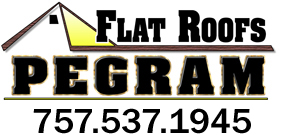Some commercial and residential roofs use Tar & Gravel or Built-Up Roof (BUR) as a roofing solution. Let’s look at both solutions. Both solutions work on a little to no slope type of roof.
First let’s define what a Tar & Gravel or Built-Up Roof (BUR) is. It’s made up of 3 to 5 laminated layers, hot tar and roofing felt. It also has a layer of bitumen and an aggregate top layer. It’s been used for well over 100 years. It works, but there are some disadvantages which we’ll get into shortly.
What’s a TPO roof? As we’ve mentioned in other posts, a TPO, Thermoplastic Polyolefin, roof is a thin rubber like single ply roofing material for low-slope roofs. It’s been used on commercial and industrial roofs since the late 1980s in both the US & Europe. It was initially used in pond liners and the auto industry. It is an alternative solution to other roofing materials such as PVC, EPDM & others and usually cheaper.
So what gives? I have a flat roof what should I choose for a roofing solution: TPO or Tar & Gravel? Let’s looks at the advantages and disadvantage of both.
Both TPO & Tar & Gravel can be about the same price depending on the installer and product used. However, that’s just about the only point where they are the same. Often times you will find that TPO is actually cheaper with many advantages whereas Tar & Gravel has more disadvantages.
When it comes to environmental questions both help with UV light in that it will reflect or absorb the UV light for roof longevity. However, TPO is cooler in the summer and warmer in the winter due to TPO reflecting and absorbing heat depending on the color used since TPO can be white, black or gray.
What are other environmental considerations? A Tar & Gravel roof with tar, felt and fiberglass isn’t recyclable at all. Whereas, A TPO roof is 100% recyclable. As anyone that has ever been around tar knows, it smells. It’s bad for the installers as well as the people around it when it’s being installed. Granted it’s a short-lived inconvenience for the building owner, not so much for the installers. They deal with it frequently. A TPO roof doesn’t have that smell, is safe for the installers and is energy star rated. A Tar & Gravel roof is not due to inconsistencies in depth. More on that later.
What about installation? A Tar & Gravel roof can take longer to install than a TPO roof as it has to be “created” on site. Remember the smell we mentioned earlier? A Tar & Gravel roof, since it’s “created” on site doesn’t have a consistent thickness. You will have some areas that are thinner than other areas. Whereas a TPO roof is manufactured so thickness is consistent across the roof. Both Tar & Gravel and TPO use heat to install but in VERY different ways. Tar & Gravel, as mentioned above, has multiple layers which involves heated layers. Did we mention the smell? Whereas TPO uses heat to “heat weld” the seams. One final point worth mentioning. Depending on the thickness of the Tar & Gravel roof your roof may need to be reinforced to accommodate the additional weight vs. a TPO roof which is no issue with regard to weight.
Let’s consider if something goes wrong. Both roofing solutions can be walked on. Both are waterproof depending on how well the installer does the install. But what if a leak happens? Leaks in a Tar & Gravel roof can be very difficult to find. Think about it from this perspective. Try finding a water path when pouring water through rocks in a garden. It’s not easy. It goes all over the place. That’s how a Tar & Gravel roof is since it has aggregate. That’s not to state that a leak can’t be found, but it’s not as easy as TPO and could be more challenging to repair. Whereas a TPO roof leak can be found and sealed using different techniques. It’s similar to finding and sealing your favorite pool float or inner-tube. You find it, patch it and walk away knowing that it’s truly found and sealed.
Final thoughts. We most certainly advise customer to use TPO instead of a Tar & Gravel roof based on what we’ve mentioned above. It’s cheaper, more environmentally friendly and, generally, easier to repair should something happen.
